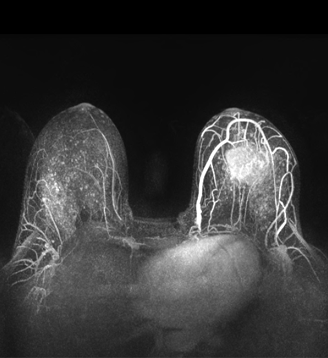Adding MRI Beneficial for Screening High-Risk Breast Cancer
An annual screening for breast cancer using a combination of MRI and mammography could be an effective program for high-risk women, particularly those who are known BRCA mutation carriers.
Using a combination of MRI and mammography could be effective for screening high-risk women.

An annual screening for breast cancer using a combination of magnetic resonance imaging (MRI) and mammography could be an effective program for high-risk women, particularly those who are known BRCA mutation carriers. These are the results of the Ontario Breast Screening Program (OBSP), the first organized screening program specifically for women at high risk for breast cancer, according to the study authors. The study was published in the Journal of Clinical Oncology.
The study compared performance measures with the screening results of 2,207 initially screened women aged 30–69. Women chosen for the analysis either had a known BRCA1 or BRCA2 mutation, another gene that predisposed them to an increased breast cancer risk, or a family history that is consistent with hereditary breast cancer and an estimated lifetime personal risk greater than 25%.
The positive predictive value was highest for detection based on a combination of mammogram and MRI screening (12.4%).
Of the women screened, 19.3% had received a prior mammogram and MRI and 33.6% had received a prior mammogram.
Recall rates were significantly higher among those women who had an abnormal MRI alone (15.1%) compared with those who had a mammogram alone (6.4%). Thirty-five breast cancers in total were detected (16.3 per 1,000). No breast cancers were detected by mammogram alone and 65.7% (23 patients) were detected by MRI alone (10.7 per 1,000); 12 patients (5.8 per 1,000) were detected by both modalities. Seventy-one percent of patients (25 total) who had cancer detected were among the women who were known gene mutation carriers (30.8 per 1,000)-the highest rate of detection in this cohort. The MRI-alone detection rate was similar to the rate reported in previous prospective studies.
The detection rates were higher among women older than 50 (23.3 per 1,000) compared with younger women (13.3 per 1,000), though not significantly.
“The first-year results suggest that the OBSP high risk screening program is achieving the expected improved performance based on the high cancer detection rate (16.3 per 1,000) provided by the addition of MRI to mammography,” stated Anna M. Chiarelli, PhD, of Prevention and Cancer Control, Cancer Care Ontario in Toronto, and coauthors, in their conclusion. “Screening with annual MRI could be considered an important management option for women who are known BRCA gene mutation carriers.”
About 5% of women diagnosed with breast cancer are thought to harbor an inherited predisposition. Women with a family history of breast cancer have an increased risk and could face diagnosis at a younger age. Women with a BRCA1 or BRCA2 germline mutation have about a 40% and 87% lifetime risk of developing breast cancer, respectively. However, the prevalence of these cancer-predisposition genes in the general population is quite low (0.11% and 0.12%, respectively).
“The most significant aspect of this new program is that women age 30 to 69 years at high risk for breast cancer across Ontario are being screened with the combination of MRI and mammography,” stated the authors.
How Supportive Care Methods Can Improve Oncology Outcomes
Experts discussed supportive care and why it should be integrated into standard oncology care.